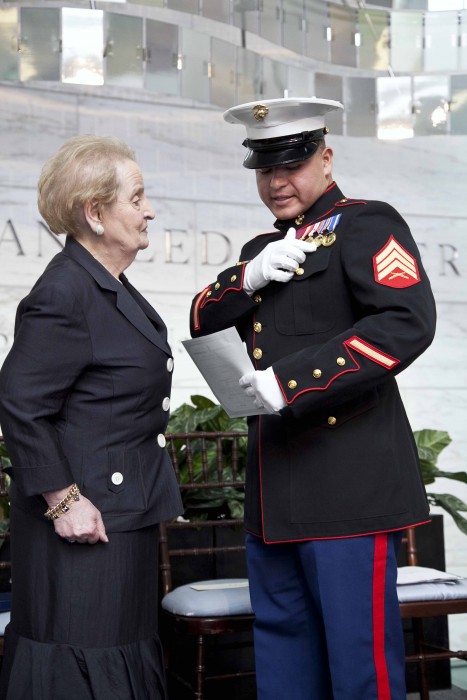What does it mean to be an American citizen?
Freedom of speech, assembly, religion, and the press—for those of us who have only lived in the United States, it is too easy to take these rights for granted. But for many around the world who do not enjoy these rights, the ideals that guide us are an inspiration and a beacon of hope.
I am the son of an immigrant. My father came to the United States with his family as a child from the area of Western Russia that is now Belarus. Before he entered the U.S., he lived for two years in Cuba. Ever grateful to be an American citizen, at an early age he instilled in me the importance of participating in our democracy; of exercising the right to vote; of making our voices heard. He felt it was our duty as citizens.
Freedom of speech, assembly, religion, and the press—for those of us who have only lived in the United States, it is too easy to take these rights for granted. But for many around the world who do not enjoy such freedoms, the ideals that guide us greatly inspire others and are beacons of hope. That is why so many sacrifice so much to come here, as my family did nearly a century ago.
At the National Museum of American History and many other museums and galleries across the Smithsonian, we tell the story of our democratic system of government and our continuing struggles to live up to our ideals. Incisive research, extensive outreach, and the iconic objects in our collections—the Star-Spangled Banner, Lincoln’s silk top hat, shackles from the sunken Portuguese slave ship São José, Amelia Earhart’s plane, Cesar Chavez’ union jacket, the figure etched with intricate symbols known as “The Cosmic Buddha,” the Space Shuttle Discovery—each in its own way helps us tell those stories.
Our nation’s ideals are symbolized in our flag and embodied in one of our country’s most patriotic events—the swearing-in ceremony for new citizens. Each year, in town halls, libraries, and courts across the nation, the United States welcomes more than 700,000 new citizens. And each year, since 2008, the National Museum of American History joins in this civic ritual. We have either held this ceremony on Citizenship Day in mid-September, or as we do this year, on June 14, Flag Day.
In 2008, NMAH re-opened after its center core renovation and entered into a partnership with the United States Citizenship and Immigration Services to host naturalization ceremonies. Dignitaries such as President George W. Bush, Secretary Jeh Johnson, Secretary Hilda Solis, Secretary Madeleine Albright, and Secretary Hillary Clinton have been there to congratulate these men and women on their new status. On Flag Day in 2014, NMAH hosted Raise it Up! to celebrate the bicentennial of the Star-Spangled Banner and welcomed 15 new citizens, one for each star and stripe of the flag.
I look forward to taking part in this year’s ceremony. It will be a great day for the Smithsonian and the country. And it will be particularly poignant for me since I just returned from a cultural delegation to Cuba in April sponsored by the President’s Committee on the Arts and Humanities. While there, I learned so much about the nation that welcomed my father so many years ago, before he made a permanent home in the United States.
President Obama has observed of the U.S., “No other nation in the world welcomes so many new arrivals. No other nation constantly renews itself, refreshes itself with the hopes, and the drive, and the optimism, and the dynamism of each new generation of immigrants.” Statistics bear this out, as according to the Partnership for a New American Economy, in 2011, immigrants started 28% of all new U.S. businesses, despite accounting for just 12.9% of the U.S. population. And according to non-partisan think tank the National Foundation for American Policy, immigrants have started more than half of U.S.-based startups valued at $1 billion or more.
You can see such stories on display at NMAH. Entrepreneurs abound in the Innovation Wing which opened last July, from Dora Hilda Escobar, an immigrant from El Salvador who built a business of restaurants, to Ralph Baer, a German immigrant who escaped during WWII and went on to invent the first video game system, the Magnavox Odyssey.
In the summer of 2017, Many Voices, One Nation will open at NMAH. It will describe how immigration made the United States a uniquely dynamic society steeped in cultural and technological innovations. This year’s naturalization ceremony will once again include the awarding of the James Smithson Bicentennial Medal to a person who has contributed to our country and the world. Past winners have highlighted the connection between immigration and innovation, included robotics expert and computer scientist Sebastian Thrun, a German national with dual citizenship in the U.S., and fashion designer, entrepreneur and philanthropist Ralph Lauren, who is the son of Ashkenazi Jewish immigrants from the same area of the world from which my father hailed.

Former Secretary of State Madeleine Albright and Sgt. Christhian Lujan at the Naturalization Ceremony in Flag Hall at the National Museum of American History, May 24, 2012.
In 2012, 12 people from 12 different countries took the oath of citizenship in Flag Hall at NMAH, among them U.S. Marine Corps Sergeant Cristhian Lujan, born in Mexico. Sergeant Lujan, who had served tours of duty in Iraq and Afghanistan, said joining the Marines was his childhood dream. What does becoming a U.S. citizen mean to him? He said, “I will have a say, a voice that will be heard. The right to vote and make a decision that will count towards my future and that of my family.”
The same lesson my father taught me decades ago, one that is as relevant today as it was then.
Posted: 1 June 2016
-
Categories:
American History Museum , From the Secretary , History and Culture




